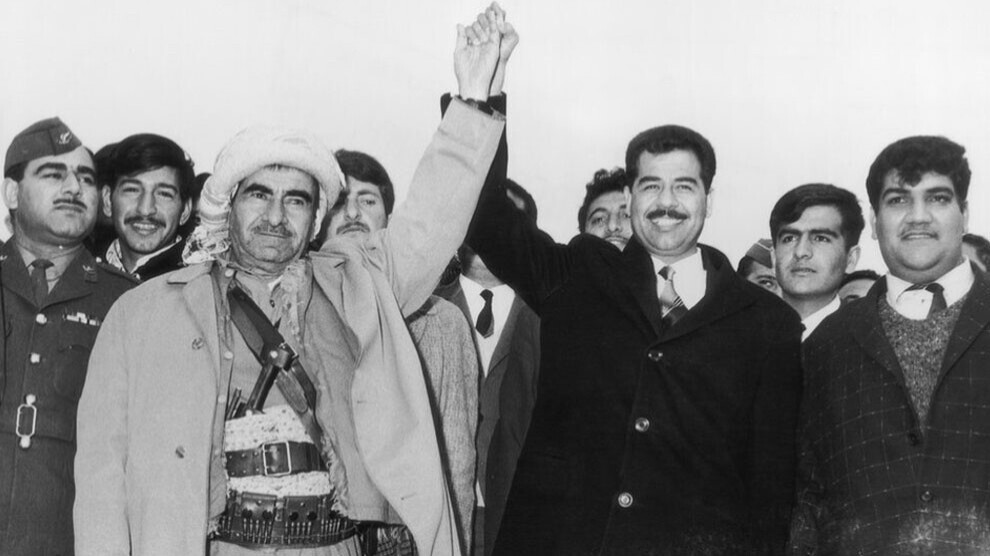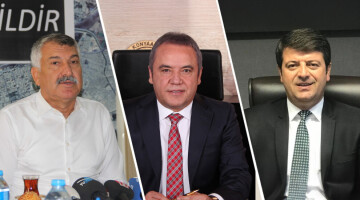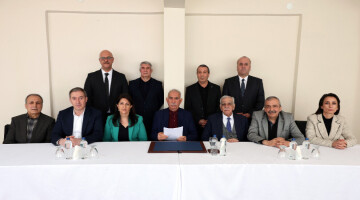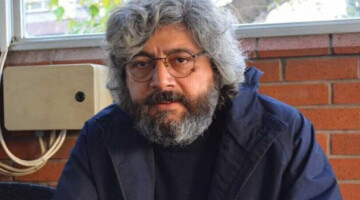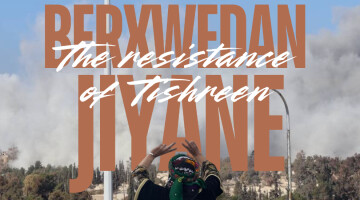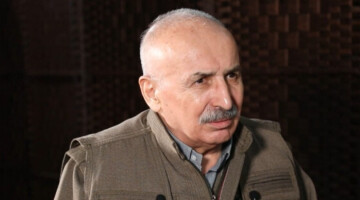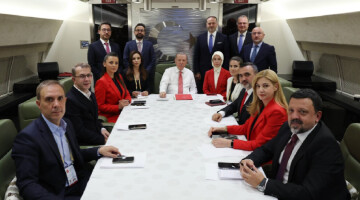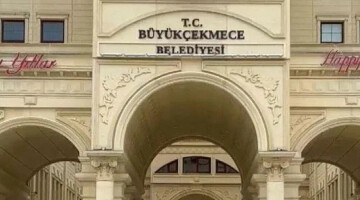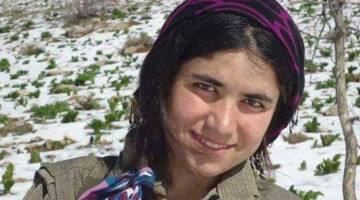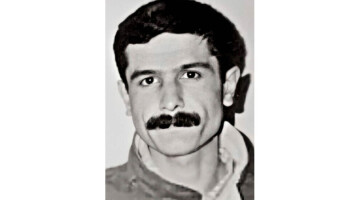The Democratic Party of Kurdistan (Partiya Demokrata Kurdistanê, KDP) was founded in South Kurdistan in 1946. Since then, it has represented a major obstacle to democratization and liberation in all parts of Kurdistan. Today the KDP is working with the Turkish regime to take action against the PKK, the Yazidis in the Shengal region and the Rojava revolution. It is preparing for a major war that could wipe out all Kurdish gains.
The Barzani clan's hostility to the Kurds goes back into the past
Anyone who wants to understand the politics of the KDP has to look back to the history of the Barzani clan, which runs the party and thus the South Kurdish government like a family business. The Kurdish hostility and the counter-revolutionary approach of the Barzani clan is older than the KDP itself. The KDP has built up structures in all four parts of Kurdistan and collaborated with the colonial states in combating the Kurdish struggle for freedom. It has collaborated sometimes with Iran, sometimes with Iraq and sometimes with the Turkish state against other Kurdish forces thus perpetuating the colonial status of Kurdistan.
With the French-inspired centralization policy of the Ottoman Empire and the associated dissolution of the Kurdish principalities, the Barzani family appeared on the stage of history for the first time in the 19th century. The Barzani clan owes its rise to the Nakschibendi order. The family presumably comes from the Mosul region and began to settle in the Barzan region in south Kurdistan with a permit obtained from the Nakschibendi sheikdom of the Sadatê Nehrî family. This sheikh family produced very powerful personalities such as Sheikh Ubeydullah who played an important political role in the second half of the 19th century and came into conflict with Abdulselam Barzani over the claims of the sheikdom in the region. As a result, Abdulselam Barzani had to flee, but his son Muhammed was finally able to enter the sheikdom with the permission of the Nehrî sheikhs.
Kurdish tribes targeted by the Barzanis
The influence of the Barzani clan grew through the sons of Şêx Muhammed, Şêx Abdusselam II, Şêx Ahmet and Şêx Molla Mustafa Barzani. As a first step, they began to attack the Kurdish tribes that traditionally settled in the Behdînan region. They waged war against all: against the tribes of the Zêbarî, Bradostî, Sûrçî, Herkî, Berwarî and Ertoşî. Again and again there were conflicts with the Ottoman Empire. After one of these conflicts with the Ottomans, Şêx Abdulselam was executed in Mosul in 1916. As a result, Şêx Ehmed became the main sheikh and began a war against the Bradostî tribe and the other tribes of Behdînan in the 1930s.
Mola Mustafa sought protection from the Turkish state
The chief of the Bradostî tribe, Şêx Reşîd Lolani, accused the Barzanis of "corrupting the religion and diverting it from the right path". As the Barzani family waged war against all the tribes in the region, British and Iraqi forces finally intervened in the region. After a British air raid, Şêx Ehmed and Mola Mustafa Barzani fled to Turkey. They were extradited to Iraq by the Turkish state in 1933 and lived in exile in Sulaymaniyah for a long time.
Mola Mustafa Barzani abandoned Mahabad
In 1945 Mola Mustafa Barzani went to Eastern Kurdistan (Rojhilat). There he assumed responsibility for the defense of the Kurdish Republic of Mahabad, which was founded in 1946. When the Iranian regime turned against Mahabad, he offered no resistance, but fled to the Soviet Union instead.
Barzani tries to destroy other parties
When Barzani was in exile, the KDP Iraq was founded on the model of the Iranian KDP. Barzani stayed in the Soviet Union for eleven years and returned to Iraq when the military Abd al-Karim Qasim came to power. After his return to South Kurdistan, Mola Mustafa Barzani tried, using regional forces, to accelerate the destruction of other Kurdish forces and parties.
Barzani coup in the KDP
In 1964 Barzani agreed an armistice with Iraq without informing the KDP Politburo. Thereupon the Politburo of the KDP gathered and expelled Barzani. However, Barzani declared the meeting invalid, organized a party congress with his supporters, closed the legal politburo and created a new politburo from his loyalists.
Collaboration with colonialists
In this way Mola Mustafa Barzani has got control of the whole KDP and a collaboration with the regional states against freedom movements in all parts of Kurdistan began. Since then there has probably not been a Kurdish force that was not fought against by the KDP.
From yesterday to today: a chronology of war and collaboration
If we review the last 60 years alone, the result is shocking:
1961: With the end of relations between the KDP and Baghdad, the party turns to Iran. The KDP-Iraq will soon take action against the KDP-Iran together with the Iranian regime. It murdered KDP-Iran leadership cadres such as Silêman Maunî. His body is handed over to the Iranian regime by the KDP Iraq.
1964/65: During these years, the Barzani KDP launched several large and small attacks on Ibrahim Ehmed, whom he had recently thrown from the party, Celal Talabani and the party's former Politburo, which they had previously excluded from the party. As a result, they are forced to flee to Iran.
1965: Faik Bucak, General Secretary of KDP Turkey, writes to Mustafa Barzani about the founding and goals of his party. Shortly after the letter was sent, Faik Bucak is murdered by the Turkish state.
1966: In that year the KDP fights against a front led by Ibrahim Ehmed and Celal Talabani. There are many dead on both sides.
1968: Barzanis KDP works with the Savak, the secret service of the Iranian Shah regime, to crush the KDP-Iran. For this, the KDP Iraq receives massive support from the Savak. In joint operations between the Iranian regime and the KDP-Iraq in southern and eastern Kurdistan, many Peshmerga of the KDP-Iran are killed and the party largely eliminated.
1971: Sait Elçi, the successor to the murdered KDP Turkey General Secretary Faik Buçak, is mysteriously murdered. Dr. Şivan (Sait Kırmızıtoprak) had founded the KDP Turkey of the same name, which aimed at a guerrilla war in Turkey. He was shot dead on 26 November 1971 allegedly by MIT.
1975: After the Algiers Agreement, Iran withdraws its forces from Iraq. Molla Mustafa Barzani called for the end of the resistance and withdraws to Iran. In the same year Celal Talabani founded the Patriotic Union of Kurdistan (YNK, PUK in English). The PUK is immediately targeted by Barzani’s KDP.
1976: Molla Mustafa Barzani began a bloody conflict with the PUK. However, the Barzani party is defeated and forced to withdraw to Iran.
1978: After the KDP ended the resistance against the Ba'ath regime, a group of PUK Peshmerga under the command of Elî Eskerî is ambushed on the border between Hakkari and south Kurdistan. According to reports, Molla Mustafa Barzani declared: “Big men are killed with big weapons” and killed him with an RPG-7 rocket launcher.
1979: The Barzanis reorganize the KDP in Mahabad, in Eastern Kurdistan, where they have withdrawn. Because of their cooperation with the Iranian regime against the KDP-Iran, they do not receive any support from the population. They then attack the tribes in the region.
1980: There are always battles between the KDP and YNK.
1981: This time the KDP-Iraq of the Barzanis collaborated with the Iranian mullah regime and attacked the Dr. Qasimlo-headed KDP Iran again. The KDP-Iran is massively weakened.
1992: After the 2nd Gulf War, the South Kurdish Parliament is founded. The first decision by this Parliament is to declare war on the PKK.
1994: Even if the internal conflict visibly decreased by then, the KDP declares war on the PUK. It is about the income from the Ibrahim Halil border crossing and the sole rule of the KDP. In the war that lasted until 1997, both sides lost tens of thousands of people, and tens of thousands more had to flee the country.
1995: The KDP and the Turkish state jointly launched the "Çelik" operation against the PKK. The attacks began on March 12th and last into May.
1996: On August 31, 1996 the KDP allied itself with the mass murderer of the "Anfal Operation", Saddam Hussein, in order to attack Hewlêr, which is controlled by the PUK, and bring it under sole rule. The KDP took Hewlêr with the help of Saddam's tanks.
1997: At the same time as the Turkish state's hammer operation against the PKK is launched, hospitals in Hewlêr, in which wounded guerrilla fighters are cared for, the newspaper Roji Welat and the cultural center Mesopotamya are stormed. The KDP murdered 80 wounded guerrilla fighters and alleged or real PKK supporters.
2012: With the beginning of the revolution in Rojava, the KDP, through its Rojava offshoot, the ENKS (Kurdish National Council), takes part in massacres such as in Til Harran and Til Hasil and a multitude of attacks and counter-revolutionary activities from Serêkaniyê to Afrin.
2014: The KDP withdraws troops from Shengal overnight and leaves the previously disarmed Yazidi population to the "Islamic State".
2017: The KDP attacked Yazidi self-defense forces in Sinûnê and Xanesor.
2017: Despite all warnings, the KDP pushed through an independence referendum. After the referendum, it left all controversial places without a fight and left 48 percent of south Kurdistan to the Iraqi military.
2018: Armed groups from the KDP continuation ENKS take an active part in the attack on the autonomously administrated Afrin.
2020: On October 9, the KDP concluded an agreement with the Iraqi government to regain control of the Shengal region and to disband the self-defense forces of the Yazidis.
Many more examples could be added to this list. With its escalation strategy against the PKK in North, West and South Kurdistan, the KDP is pursuing the goal of being the only Kurdish power at the grace of Turkey to be able to assert itself. Despite protests from all sides, the KDP is sticking to this goal.

